| Article ID | Journal | Published Year | Pages | File Type |
|---|---|---|---|---|
| 2101902 | Biology of Blood and Marrow Transplantation | 2014 | 7 Pages |
Identification of pretransplantation risk factors is important in evaluating patient outcomes after hematopoietic stem cell transplantation. Current scoring schemes, such as the European Group for Blood and Marrow Transplantation risk score or the Hematopoietic Cell Transplantation-Specific Comorbidity Index, may under-rate disease and disease status at the time of transplantation. The recently published Disease Risk Index (DRI) specifically investigates these aspects by defining 4 risk groups (low, intermediate, high, very high) with significant differences in overall survival (OS). We retrospectively investigated whether the DRI could be applied at the transplantation center of Geneva's University Hospitals (Geneva, Switzerland), where 64% of patients are underwent transplantation with T cell–depleted grafts (TDEP). We analyzed 409 patients with various hematological malignancies who underwent transplantation between January 1998 and October 2012. Using the DRI, the 4-year OS for the low, intermediate, high, and very high groups was 82%, 53%, 27%, and 31%, respectively (P < .0001). For TDEP patients, the 4-year OS for low, intermediate, and high overall risk groups was 86%, 53%, and 33%, respectively (P < .0001). As patients in the very high overall risk group are usually not eligible for TDEP, our group comprised too few patients (n = 3) for meaningful analysis. For non-TDEP patients, the 4-year OS for low, intermediate, high, and very high overall risk groups was 63%, 54%, 22%, and 18%, respectively (P < .0001). Our results confirm the prognostic value of the DRI in a cohort with a majority of TDEP patients.
